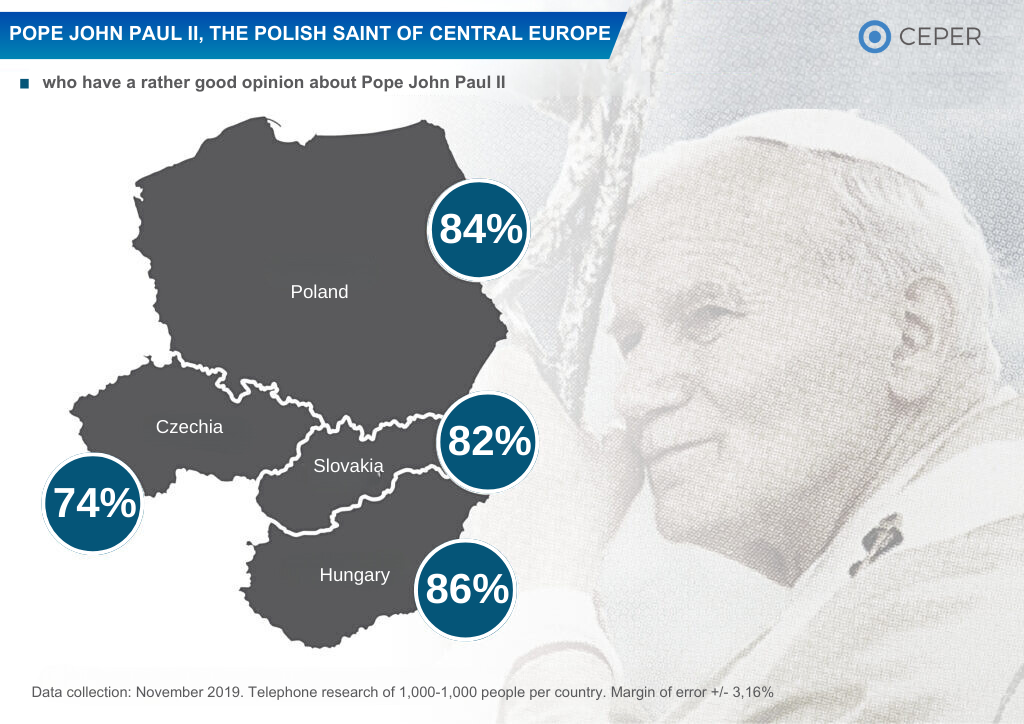St. Pope John Paul II – The Polish Saint of Central Europe
Karol Wojtyła, or St. Pope John Paul II as the world knows him, was born over a hundred years ago on 18 May 1920. As the sole Polish pope of the Roman Catholic Church so far, he is the subject of unparalleled veneration in the region: even today at least three-quarters of the population of all four Visegrad states continue to hold him in high regard. The late pope is now a Central European saint, and his lasting popularity can also be explained by the special attention he had paid to the region.
According to an opinion poll from 2019, when St. Pope John Paul II celebrated his 100th birthday, the pope enjoys enduring fame and popularity in V4 countries. Only 3 per cent of respondents in the four countries said they had never heard of him. His 26-year-long governance of the Church played a key role in his visibility, and yet his universally shared recognition is still somewhat surprising, as St. Pope John Paul II as well as his deeds and overall legacy have received little attention in recent years.
St. Pope John Paul II is just as popular as widely recognised: more than four-fifths (82 per cent) of the respondents from Visegrad countries have a favourable opinion of him. Data for individual countries do not show a high variance. 86 per cent of Hungarians, 84 per cent of Poles, and 82 per cent of Slovaks share the same opinion. Only in the highly secular Czechia, where 51 per cent of respondents described themselves as non-religious, lagged the pope’s popularity slightly behind. Nevertheless, even in Czechia St. Pope John Paul II’s image was positive, with 74 per cent of respondents having a favourable opinion of him.
Breaking down the results by age group, settlement type and education level do not lead to different observations from the ones discussed above. St. Pope John Paul II is well known and respected among young people too, particularly in Poland, where he is the most popular among those under 30 (87 per cent) – that is, among those who were far from being adults when the pope died 15 years ago.
The late pope’s lasting popularity cannot be explained by one reason, multiple factors from religious teaching through his authenticity to the use of modern communication tools all greatly contributed to his reputation. There is, however, and even deeper reason behind his undeniable popularity in Central Europe in particular. The Polish pope is not merely a Central European saint, but also a saint of Central Europe.
 He used his office to fight communist totalitarianism and paid special attention to his wider homeland once it re-joined the free world. When he visited all Central European countries, the late pope formulated his words of encouragement and caution with a sharp foresight into the future. In 1991, on the 100th anniversary of the Social Encyclical of the Catholic Church, he wrote: “The events of 1989 took place mainly in the states of Eastern and Central Europe, yet they are of universal significance because they have good and bad consequences for the whole human family. These consequences are not merely mechanical or fateful, but rather opportunities offered to human freedom to cooperate with the intentions of a merciful God in history.” (Centesimus Annus)
He used his office to fight communist totalitarianism and paid special attention to his wider homeland once it re-joined the free world. When he visited all Central European countries, the late pope formulated his words of encouragement and caution with a sharp foresight into the future. In 1991, on the 100th anniversary of the Social Encyclical of the Catholic Church, he wrote: “The events of 1989 took place mainly in the states of Eastern and Central Europe, yet they are of universal significance because they have good and bad consequences for the whole human family. These consequences are not merely mechanical or fateful, but rather opportunities offered to human freedom to cooperate with the intentions of a merciful God in history.” (Centesimus Annus)
In one of his late conversations in 2005, St. Pope John Paul II expressed what he thought Eastern Central Europe could do to shape a united Europe, stressing that “the most important contribution that the countries of this region can offer is the protection of their own identity. The biggest danger Eastern Europe is exposed to is the confusion of its own identity […] And this danger lies in taking on the negative cultural model prevalent in the West without criticism […] I think there has been a great intellectual struggle going on in recent times, the outcome of which will define the face of Europe.” (Memoria e identità) His thoughts continue to be relevant even fifteen years after his death.
Methodology
The telephone interview based (CATI) survey took place in November 2019 in four Central European countries (Hungary, Poland, Czechia, Slovakia) with the participation of 1000 respondents from each country. The sample is representative of the 18+ population for gender, age, region, settlement type and education level. Given the sample size, the maximum margin of error is 3.2 percent.